



February 2014
Trifid Nebula
NASA's Wide-field Infrared Survey Explorer (WISE) has been revealing the Trifid Nebula in infrared. The Trifid Nebula is located 5,400 light-years away in the constellation Sagittarius. The nebula is a star nursery, where baby stars are being born. The yellow and orange areas of this photo are where these stars are created.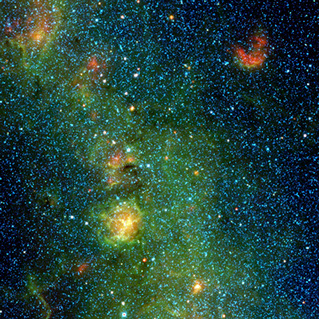
The various colors in the photo represent different infrared wavelengths. Blue is the 3.4 micron wavelength, blue-green is 4.6 microns, green is 12 microns and red is 22 microns. The blue and green-blue is mainly from hot stars while the green and red are the cooler objects such as dust in the nebula.
The green cloud is hydrogen gas. The red clouds are caused by gas being heated by the young stars as they form.
The nebula appears dark when viewed in visible light. By looking at it in the infrared spectrum, however, the star-forming areas are bright. WISE is opening new insights into the nature of forming stars.
PHOTO: NASA/JPL-CalTech
Visit our sponsors.
For advertising opportunities on this page and our videos, contact
Supernova SN 2014J
On January 21, a supernova blast was detected in the Cigar Galaxy, M82, located in Ursa Major. It is a rare opportunity to study a supernova explosion, so observatories around the world and in space aimed their instruments there. The supernova was first detected by Steve Fossey and his students at the University of London while imaging M82 during a workshop. Soon the Hubble Space Telescope, the Chandra X-ray Observatory, the Nuclear Spectroscopic Telescope Array (NuSTAR), the Fermi Gamma-ray Space Telescope and the Swift Space Telescope all hurried to observe the event.
Swift was the first begin observations using its Ultraviolet/Optical Telescope (UVOT). Mid-ultraviolet wavelengths are obscured by the dust in the galaxy, but Swift was able to obtain detailed images in the visible and near-ultraviolet wavelengths.
SN2014J is a type 1a supernova, which is a total destruction of a white dwarf star. The explosion produces a superheated shell of plasma that expands outward into space at tens of millions of miles an hour. The shell is kept hot by short-lived radioactive elements. Astronomers estimate that SN2014J will continue to expand and brighten into the first week of February and will be able to be seen with binoculars on earth.
X-rays during a supernova event have not been observed in much detail. Swift's X-ray telescope, Chandra and NuSTAR will provide significant new data in this area. Fermi will also be able to capture never before obtained Gamma-ray data.
The photos below were taken with Swift's UVOT camera. They show M82 before and after the event. The supernova is shown in the circle. Blue colors are mid-ultraviolet light, green is near-ultra-violet and red is visible light.
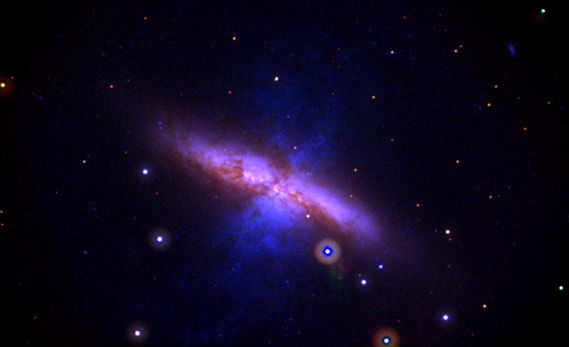
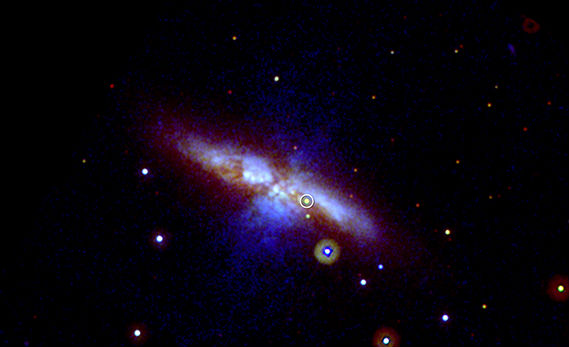
PHOTO: NASA/Swift/P.Brown, TAMU
Upcoming Launches
Date: February 5
Launch Vehicle: Russian Soyuz
Launch Site: Baikonur Cosmodrome, Kazakhstan
Description: Progress 54 will deliver cargo and crew supplies to the International Space Station
Date: February 22
Launch Vehicle: Falcon 9
Launch Site: LC 40, Cape Canaveral AFS, Florida
Description: SpaceX-3 will be the third commercial resupply mission to the International Space Station by SpaceX.
Date: February 27
Launch Vehicle: H-IIA
Launch Site: Japan Aerospace Exploration Agency (JAXA) Tanegashima Space Center, Japan
Description: GPM is an international satellite mission to provide next-generation observations of rain and snow worldwide.
Archived Issues
Ultra-Massive Black Hole
There may be not only a super-massive black hole, but an even larger ultra-massive black hole at the center of a galaxy 3.9 billion light-years from Earth. NASA's X-ray space telescope, Chandra, has been studying the galaxy cluster RX J1532 and has detected very bright x-rays indicating the cluster is extremely massive, about a quadrillion (thousand-trillion) times that of our sun. At the center is a super-massive black hole.
The hot gas containing the x-rays at the center should cool and the pressure drop causing gas further out to start forming stars. But this is not happening. Why? Images from Chandra and radio data recorded at the VLA shows two large cavities on either side of the center. This indicates that supersonic jets generated by the black hole have drilled into the hot gas and pushed it aside. This formed the cavities. Sound wave would then reverberate through the hot gas and provide a source of heat the prevents the gas from cooling and forming new stars.
X-ray data does not detect any material falling into the black hole, so for the jets to form without a large amount of mass falling into the black hole, scientists believe the black hole would have to be more than super-massive. It would be Ultra-massive, more than 10 billion times that of the sun.
Another cavity has been detected at a different angle. This indicates the black hole may be wobbling like a spinning top.
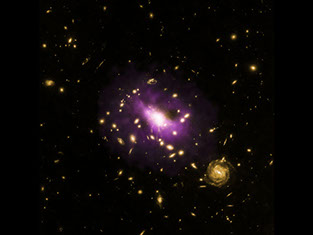
The purple color in this photo represents X-ray data from Chandra and the yellow color is optical photos taken by Hubble.
Credit: X-ray: NASA/CXC/Stanford/J.Hlavacek-Larrondo et al, Optical: NASA/ESA/STScI/M.Postman & CLASH team
Water on Ceres
ESA's Hershel space observatory is no longer operational, but scientists will be studying the data for years to come. This data has recently revealed that the dwarf planet Ceres contains water vapor.
Ceres has an icy surface and when it warms slightly plumes of water vapor are shot into the atmosphere. The presence of these plumes proves that Ceres does in fact have an atmosphere.
Herschel made several observations of Ceres during its mission and at times saw these plumes and at other times did not. When Ceres' orbit brings it closer to the sun, the plumes can be seen. When Ceres is farther away in its orbit, there are no plumes. This indicates that the surface becomes warm enough to cause the water vapor at certain times when Ceres is closer to the sun.
It is believed that Ceres may contain more water than Earth. The water is currently in the form of ice laying above a rocky surface. Until now, the presence of the ice was only theorized, but Herschel's far-infrared data has given a clear water signature.
Ceres, like Pluto, is classified as a dwarf planet. It is larger than an asteroid but smaller than a planet. Ceres is located in the asteroid belt between Mars and Jupiter. NASA's Dawn spacecraft is currently en-route to Ceres to arrive in spring of 2015. When Dawn arrives it will be able to study the dwarf planet up close.
Rosetta Awakens
At 19:18 (7:18 PM) local time at the European Space Operations Center in Darmstadt Germany, a signal from the spacecraft Rosetta was received. After 957 days in hibernation, Rosetta awoke.
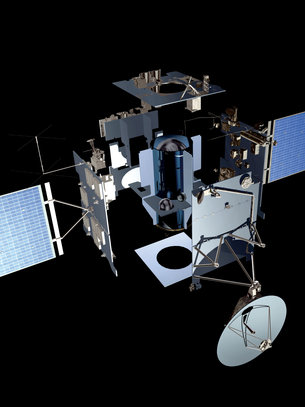
Rosetta is heading toward comet 67P/Churyumov-Gerasimenko. It is scheduled to arrive at the comet in August of this year to begin its near two year mission. The spacecraft will not only observe the comet close-up from space but will send a lander to the surface of the comet.
The orbiter contains 11 science instrument packages. It will study the comet in both visible and infrared wavelengths, record radio science, measure microwave activity, analyze the dust and grains ejected from the comet, gather spectrometer data in ultraviolet, and analyze Ion mass and plasma.
The lander, Philae, contains 10 science instrument packages. It will image the comet in various wavelengths including x-ray, record radio science, measure the gases, monitor electrical and acoustics, monitor dust impacts, gather magnetic data, and it will drill into the surface to study the surface and substrate.
Brown Dwarf Weather
The European Southern Observatory's Very Large Telescope in Chile has been observing Luhman 16B, a Brown Dwarf. A Brown Dwarf is somewhere between a large gas planet like Jupiter and a star. They are not massive enough to initiate nuclear fusion, but they still glow in the infrared spectrum of light.
As Luhman 16B rotated, the VLT was able to image and map out the dark and light features on the surface. These are weather patterns, clouds, in the atmosphere. The atmosphere of a Brown Dwarf is very similar to that of a hot gas giant exo-planet. So by studying the much closer Brown Dwarf, we gather insight into the large exo-planets orbiting other stars. Hot gas giant exo-planets are around the size of Jupiter but are in an orbit very close to their sun, thus making them very difficult to study from earth.
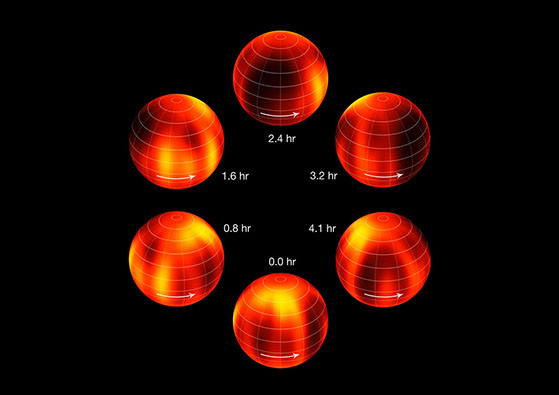
Credit: ESO/I. Crossfield
Credit: ESA
© 2014-2016 Ted Cook Productions LLC. - All Rights Reserved